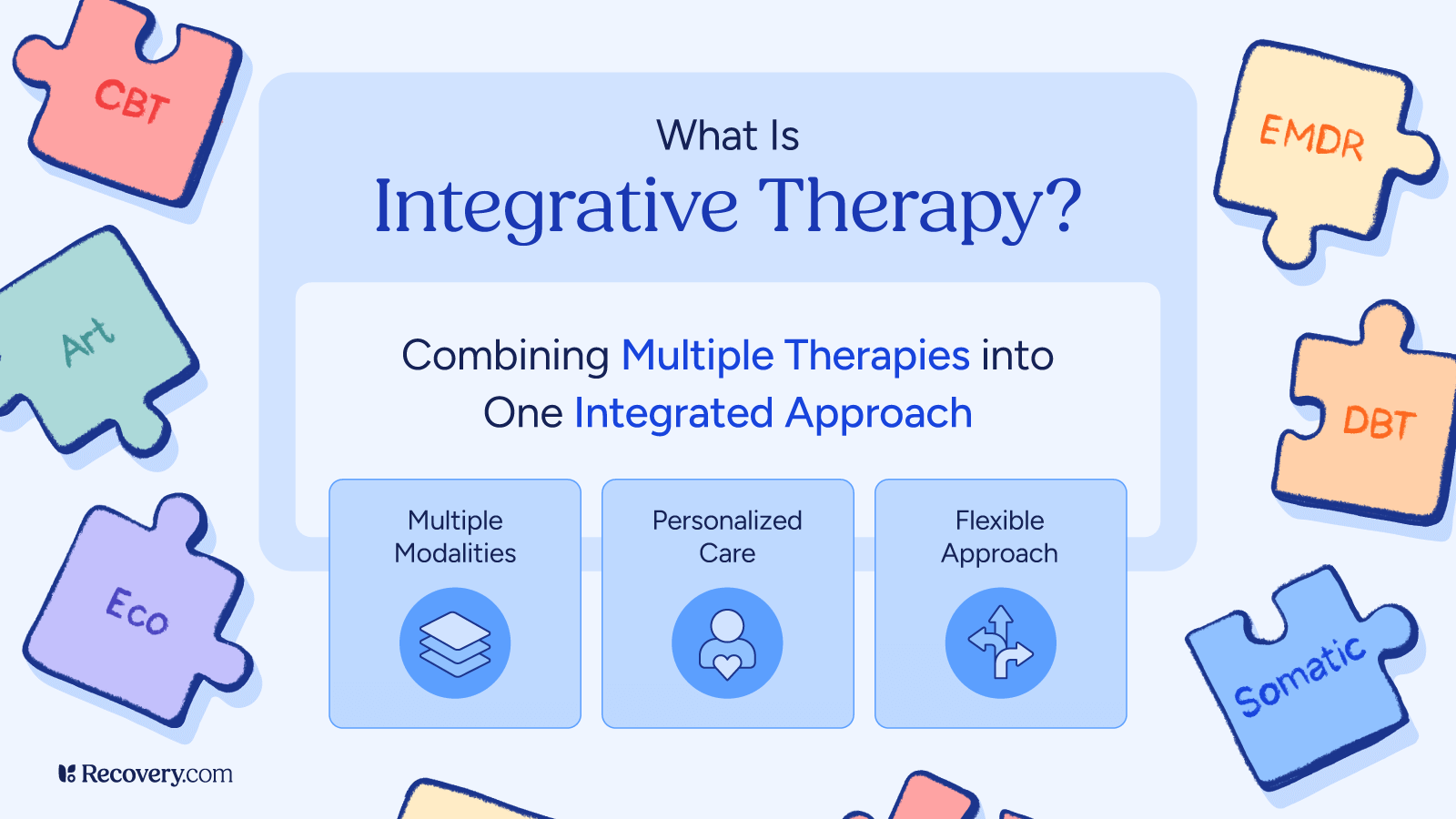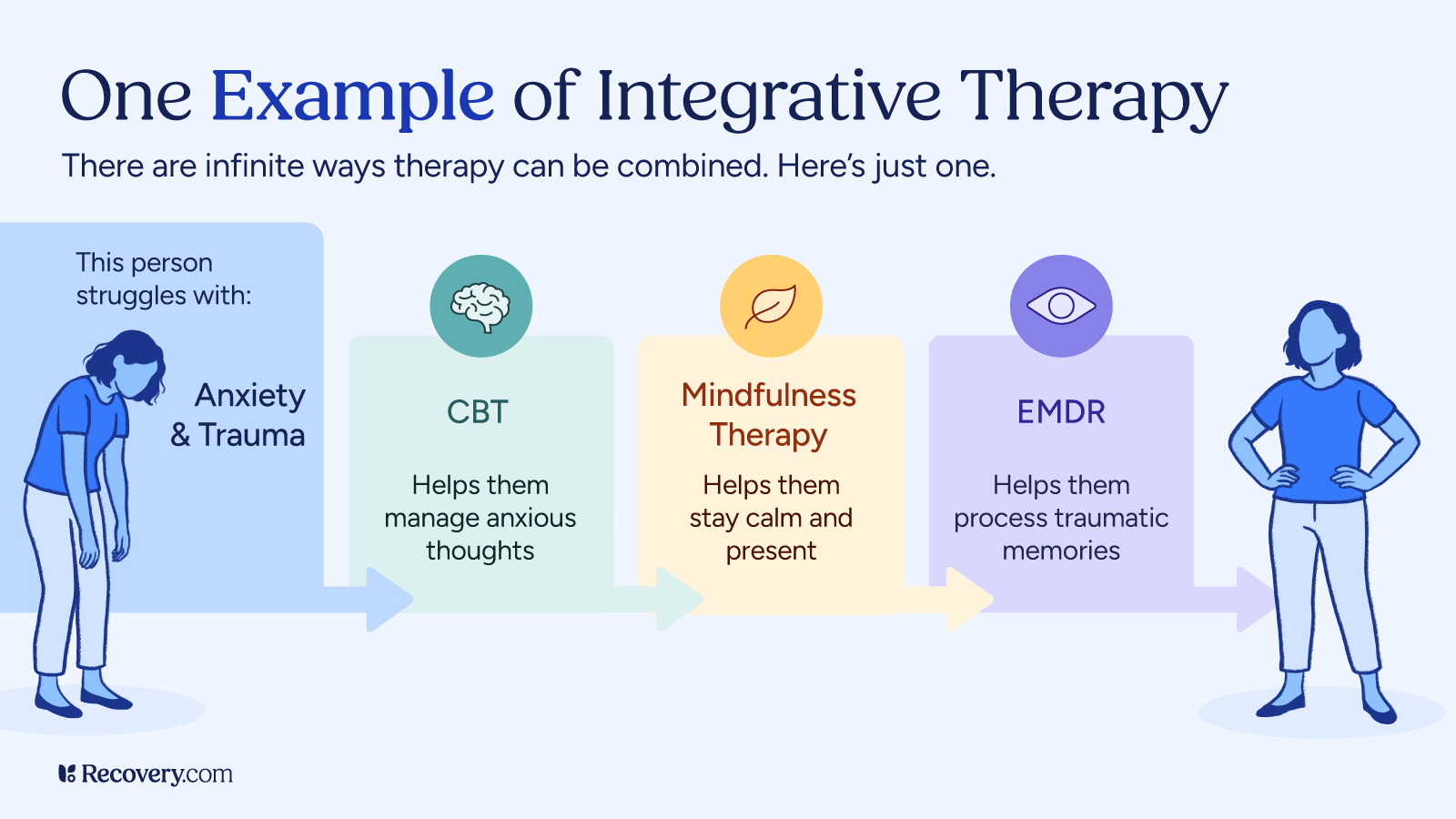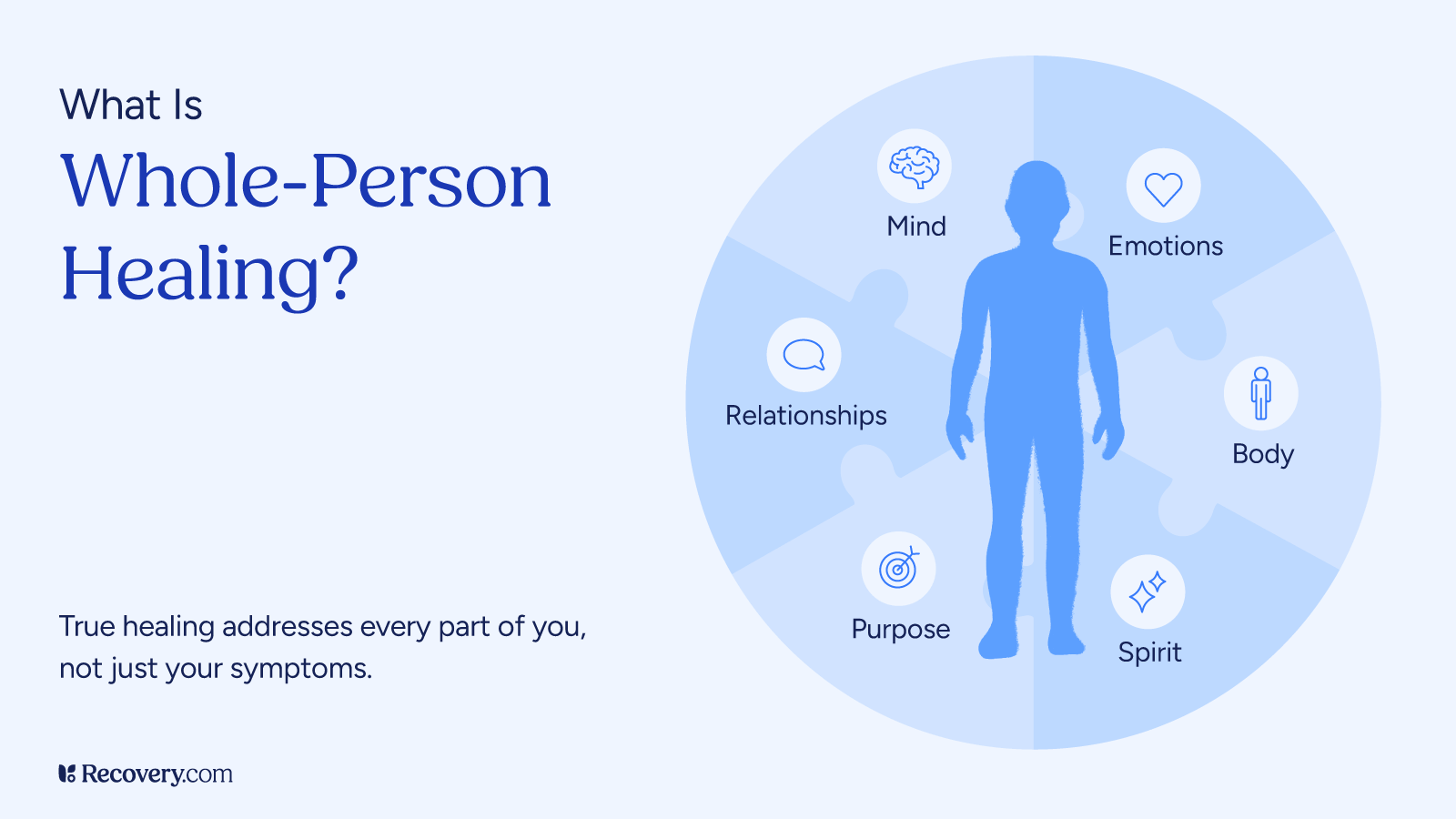Integrative Therapy: 5 Advantages for Whole-Person Healing


Kayla holds over 6 years of experience in the rehab space, including in-house content management at a leading treatment center. She believes addiction and mental health issues are universal human experiences that can serve as important entry points onto a path toward self-realization and well-being.



Kayla holds over 6 years of experience in the rehab space, including in-house content management at a leading treatment center. She believes addiction and mental health issues are universal human experiences that can serve as important entry points onto a path toward self-realization and well-being.
Table of Contents
Mental health and addiction treatment look different for everyone. What helps one person might not work for another, and many people find that a single therapeutic approach doesn’t address all their needs. This is where integrative therapy comes in.
This flexible approach has become increasingly popular in both mental health and addiction treatment settings. Many treatment centers now use integrative methods because they can adapt to complex, co-occurring conditions that many people face.
Here, you’ll learn how integrative therapy works, what types of treatments it combines, and how it might benefit your treatment experience.

What Is Integrative Therapy?
Integrative therapy combines different evidence-based treatment methods1 to create a personalized approach for each person. Instead of relying on just one type of therapy, it draws from multiple techniques to address your unique challenges and goals. It’s like having multiple tools available for different situations.
How Integrative Therapy Works
The integrative therapy process starts with a comprehensive assessment. Your therapist will want to understand your current challenges, your history, what you’ve tried before, and what your goals are for treatment. This helps them determine which therapeutic approaches might be most helpful for you.
Based on this assessment, your therapist creates a personalized treatment plan that combines different methods. For example, they might teach you mindfulness techniques to manage stress and anxiety, and use cognitive behavioral therapy (CBT) to help you identify and change your thought patterns.
Sessions can vary depending on what you’re working on. One week you might focus on processing emotions through talk therapy, while the next session could involve somatic techniques to help you reconnect with your body. Your therapist acts as a guide, selecting the most appropriate tools for what you need at any given time.
The beauty of this approach is its adaptability. If something isn’t working, your therapist can try a different technique without abandoning your overall treatment plan. This flexibility helps ensure you’re always moving forward in your healing process.

Explore Holistic Treatment Centers
Types of Therapies Used in Integrative Treatment
Integrative therapy can draw from any number of evidence-based approaches. Your treatment team will select the combination of therapies that best fit your needs.
Cognitive behavioral therapy (CBT) helps you identify and change unhelpful thought patterns and behaviors. It’s particularly effective for anxiety, depression, and substance use disorders. CBT provides practical tools you can use in daily life.
Dialectical behavior therapy (DBT) teaches skills for managing intense emotions, improving relationships, and tolerating distress. Originally developed for borderline personality disorder, DBT techniques are now widely used for various conditions.
Mindfulness-based interventions help you stay present and aware without judgment. These practices can reduce anxiety, improve emotional regulation, and support overall mental wellness. Many people find that mindfulness techniques are a simple, effective way to self-regulate during difficult moments.
Psychodynamic therapy explores how past experiences influence current patterns and relationships. This approach can help you understand recurring themes in your life and develop deeper self-awareness.
Somatic therapies aim to improve your mind-body connection. These approaches recognize that trauma and stress are stored in the body and work to release tension and promote healing through body awareness.
Art and expressive therapies use creative outlets like art, music, or movement to process emotions and experiences. These can help access parts of the brain that talk therapy can’t and can be especially helpful when verbalizing your experience feels too challenging.

Conditions Treated With Integrative Therapy
Integrative therapy is effective for both mental health conditions and substance use disorders. Because it can address multiple issues simultaneously, it’s especially helpful for people with co-occurring conditions.2
Depression can benefit from an integrative treatment plan that includes talk therapy, behavioral activation, and complementary techniques like creative therapy. The variety of approaches helps address different aspects of depression, such as negative thinking and social isolation.
Anxiety disorders often respond well to integrative approaches3 that combine CBT techniques with mindfulness practices and body-based interventions. This combination helps address both the thoughts and physical sensations that contribute to anxiety.
Trauma and PTSD often require multiple therapeutic approaches. Integrative treatment might combine trauma-focused talk therapy with somatic techniques and mindfulness to help process traumatic experiences safely.
Substance use disorders frequently co-occur with mental health conditions. Integrative therapy can address both the addiction and underlying mental health issues, using approaches like CBT, motivational interviewing, and mindfulness-based relapse prevention.
Integrative therapy can be especially helpful when you’re dealing with multiple mental health issues, as single types of therapy might not be enough to address everything you’re going through.
Benefits of Integrative Therapy
Integrative therapy offers several key advantages that make it appealing to a lot of people seeking treatment.
- Personalized treatment plans mean your therapy is tailored specifically to your needs, preferences, and goals. Rather than fitting into a predetermined treatment model, the therapy adapts to you.
- A whole-person approach4 addresses not just your symptoms but considers your emotional, physical, social, and spiritual well-being. This comprehensive perspective often leads to more sustainable healing.
- Flexibility to adapt as your needs change ensures your treatment remains relevant throughout your healing process. You won’t need to start over if your focus shifts or new issues emerge.
- Evidence-based effectiveness comes from combining proven therapeutic methods. Research shows that integrative approaches can be as effective5 (and sometimes more effective than) single-modality treatments for many conditions.
- Improved treatment engagement6 often results because you have more options to find approaches that resonate with you. When people feel more connected to their treatment, they’re more likely to stick with it.
Integrative Therapy vs. Other Approaches
While integrative therapy shares some similarities with other treatment approaches, there are some important distinctions.
Holistic Therapy
Holistic treatment approaches are all about treating the whole person:7 mind, body, soul, and spirit. Integrative therapy also takes a whole-person approach but emphasizes combining different evidence-based therapeutic methods.
Single-Modality Treatments
Some therapists use one, primary therapeutic approach throughout treatment. While this can be very effective, it may not address all aspects of more complex mental health scenarios.
Eclectic Therapy
This also combines different approaches but may do so less systematically8 than integrative therapy. Integrative therapy follows a more intentional, structured process of assessment and treatment planning.
The choice between these approaches depends on your needs, preferences, and the complexity of your situation. Many people find that integrative treatment approaches offer the flexibility they need for comprehensive healing.
Finding an Integrative Treatment Program
When you’re looking for integrative treatment, whether for mental health or addiction issues, there are a few factors to consider:
- Look for programs that clearly describe their integrative approach and the specific therapies they combine. Quality programs should be able to explain how they select and integrate different treatment methods.
- Ask potential providers about their assessment process and how they develop personalized treatment plans. A good integrative program will take time to understand your unique needs before recommending specific approaches.
- Consider the qualifications and training of the treatment team. Effective integrative therapy requires therapists who are trained in multiple approaches and understand how to combine them safely and effectively.
See our ultimate guide to finding a treatment provider for more details on what to look for in a program.
Ready to Explore Your Options? Start Your Comprehensive Healing Journey Here
Integrative therapy offers a flexible, personalized approach to mental health and addiction treatment. If you’re ready to explore treatment options that can adapt to your evolving needs, find a qualified treatment program to take the first step toward healing today.
FAQs
Q: What does an integrative therapist do?
A: An integrative therapist combines different evidence-based therapeutic approaches to create personalized treatment plans. They assess your specific needs and select techniques from various therapy methods that will be most effective for your situation.
Q: What is an example of integrated therapy?
A: An example might be combining CBT to address negative thought patterns with mindfulness techniques for stress management and art therapy for emotional expression, all within the same treatment plan for someone dealing with anxiety and trauma.
Q: When is integrative therapy used?
A: Integrative therapy is often used when people have complex mental health presentations, co-occurring conditions, or haven’t responded well to single-approach treatments. It’s also helpful when someone wants a more personalized, flexible treatment experience.
Q: How does it help with anxiety and depression specifically?
A: For anxiety and depression, integrative therapy might combine CBT for thought pattern work, mindfulness for present-moment awareness, behavioral activation for depression, and somatic techniques for physical symptoms, addressing both conditions comprehensively.
Q: What is the difference between holistic therapy and integrative therapy?
A: While both take a whole-person approach, integrative therapy specifically focuses on systematically combining different evidence-based therapeutic methods, while holistic therapy may incorporate a broader range of wellness practices, including non-traditional approaches.
-
Zarbo, C., Tasca, G. A., Cattafi, F., & Compare, A. (2016). Integrative Psychotherapy Works. Frontiers in psychology, 6, 2021. https://doi.org/10.3389/fpsyg.2015.02021
-
Mueser, K. T. (Ed.). (2003). Integrated treatment for dual disorders: A guide to effective practice. Guilford Press.
-
Maślankowski, J., Wolska, A., Bliźniewska-Kowalska, K., Silczuk, A., Gujski, M., Szulc, A., Kunikowska, J., & Gałecka, M. (2025). Impact of Integrated Psychiatric and Psychotherapeutic Treatment on Perceived Anxiety and Severity of Depressive Symptoms. Journal of clinical medicine, 14(7), 2175. https://doi.org/10.3390/jcm14072175
-
Ostermann, T., Langhorst, J., & Beer, A. M. (2013). The effects of integrative in-patient treatment on patients' quality of life: a meta-analysis. Evidence-based complementary and alternative medicine : eCAM, 2013, 416510. https://doi.org/10.1155/2013/416510
-
Zarbo, C., Tasca, G. A., Cattafi, F., & Compare, A. (2016). Integrative Psychotherapy Works. Frontiers in psychology, 6, 2021. https://doi.org/10.3389/fpsyg.2015.02021
-
Bailey, R., English, J., Knee, C., & Keller, A. (2021). Treatment Adherence in Integrative Medicine-Part One: Review of Literature. Integrative medicine (Encinitas, Calif.), 20(3), 48–60.
-
Sultanoff, S. M. (1997). Treating the whole person: A holistic approach to psychotherapy. The Humanistic Psychologist, 25(2), 126–137. https://doi.org/10.1080/08873267.1997.9986876
-
Romaioli, D., & Faccio, E. (2012). When therapists do not know what to do: Informal types of eclecticism in psychotherapy. Research.unipd.it. https://www.research.unipd.it/handle/11577/2534847
Our Promise
How Is Recovery.com Different?
We believe everyone deserves access to accurate, unbiased information about mental health and recovery. That’s why we have a comprehensive set of treatment providers and don't charge for inclusion. Any center that meets our criteria can list for free. We do not and have never accepted fees for referring someone to a particular center. Providers who advertise with us must be verified by our Research Team and we clearly mark their status as advertisers.
Our goal is to help you choose the best path for your recovery. That begins with information you can trust.






